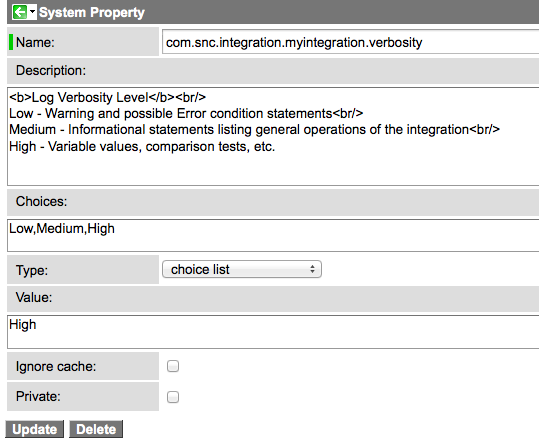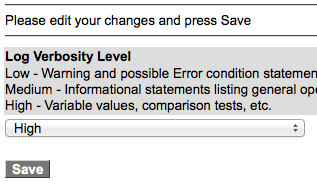Several years ago I did a blog post about creating a custom logger within ServiceNow. However, that method is a bit out of date and originally dived into Packages calls that could cause problems in the future. The following tutorial is a quick way to set up your own logging levels within ServiceNow that uses standard API calls.
Create a System Property
You will want your administrators to be able to easily change the logging level of your ServiceNow application/integration. In order to do this, you will likely use a System Property.
I created the following System Property for this purpose:

I like to give detailed descriptions for my properties. Properties can render basic HTML, so I usually take advantage of that:
1 2 3 4 |
This property uses a “Choice List” option. When using the Choice List property, you enter in your choices via a comma separated list of values. These values serve as both your field value and label. In my example, I am going to have just three log levels: Low, Medium, and High. Of course you can do whatever fits your business needs.
Once I have this set up, the user will see the following interface:

Create the functions
Now that we have our property, we will create the logging functions. Now, there are a lot of ways to do this. The following way was simple given the situation I was in. You can make it as simple or complicated as you wish.
The code for your script include may look something like this:
1 2 3 4 5 6 7 8 9 10 11 12 13 14 15 16 17 18 19 20 21 22 23 24 25 26 27 28 | var MyIntegration = Class.create(); MyIntegration.prototype = { initialize: function() { this.logSource = "MyIntegration"; //Set the Source value for the log statements this.verbosity = gs.getProperty("com.snc.integration.myintegration.verbosity", "Low"); }, //Log Everything log: function(msg) { gs.log(msg, this.logSource); }, //Only log for Medium or High levels logMedium: function(msg){ if( this.verbosity != "Low"){ this.log(msg); } }, //Only log for the High Level logHigh: function(msg){ if( this.verbosity == "High" ){ this.log(msg); } }, type: 'MyIntegration' } |
Test the Code
You can test out the code easily in your “Scripts – Background” module:
1 2 3 4 | var smi = new SolManIntegration(); smi.log("Hello"); smi.logMedium("Hello Medium Logger"); smi.logHigh("hello High Logger"); |




